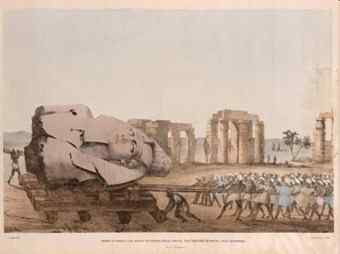“Archeological Discoveries” were on the menu for the Hi-Desert Nature Museum’s November Brown Bag Lunch lecture. Museum Supervisor Lynne Richardson introduced an assortment of characters, from the “antiquarians” of the 19th century to 1920’s Indiana Jones prototype Roy Chapman Andrews.
 Many well-to-do Europeans were traveling and collecting treasures in the early 19th century with no scientific organization, Richardson said. One of them, former circus performer and inventor Giovanni Belzoni, traveled to Cairo in 1815, where he was convinced that there was money in exporting antiquities to Britain. In his first expedition, he undertook to move a giant royal statue from the Temple of Luxor for the British Museum — making him popular in Britain but not in his host country.
Many well-to-do Europeans were traveling and collecting treasures in the early 19th century with no scientific organization, Richardson said. One of them, former circus performer and inventor Giovanni Belzoni, traveled to Cairo in 1815, where he was convinced that there was money in exporting antiquities to Britain. In his first expedition, he undertook to move a giant royal statue from the Temple of Luxor for the British Museum — making him popular in Britain but not in his host country.
Egypt was part of the Ottoman Empire at the time, and the local pashas were known to be merciless when administering the law.
“There is certainly something in the ceremonial manners of the Turk that is often peculiarly provoking” Belzoni wrote in his journal. “At the very moment they order your throat to be cut they will not fail to salute you, apparently with the utmost cordiality.”
Belzoni was ultimately successful, and using ropes, rollers and local workers, “The Young Memnon” made the trip down the Nile and over the sea to the British Museum.
Other early treasure hunters were more brash. In 1837, Richard Vyse used gunpowder and dynamite to discover several additional chambers in the Great Pyramid at Giza.
For some explorers, the culture shock was explosive. Captain John Seely of the Bombay Native Infantry went to the Hindu caves of Elephanta Island. These caves contained sacred sculpture and artwork that was erotic.
“They were actually so depraved as to indecently disfigure the deities with a variety of disgusting ornaments and appendages, so that a respectable female could not, without having her feelings outraged, visit these wonderful caverns,” Seely recorded.
In 1859, Richardson noted that Charles Darwin revolutionized scientific thought when he published “On the Origin of Species.” At the same time scientists were discovering that the earth was billions of years old, and human history went back millions of years.
“This opened up the line of inquiry for archeology,” Richardson said. “The antiquarians hadn’t been interested in what the artifacts could tell them, they just liked cool stuff!”
One of the most famous of the last antiquarians was Heinrich Schliemann. When only 8 years old, Schliemann declared that he would find the City of Troy.
He made a fortune as a banker in California during the Gold Rush, and another fortune as a military contractor during the Crimean War to fund his search for the classical city.
In 1868 he excavated an existing site in what is now Hisarlic, Turkey. He found a treasure of gold, which he thought belonged to the King Priam of Troy. He also found a gold mask, which he called the Mask of Agamemnon, for a commander in the Trojan War.
Gold was often the driving force for these adventures. Karl Mauch claimed he found King Solomon’s Mines and the gold of Biblical Ophir in South Africa.
It wasn’t until 1907 that David Randall MacIver traveled to Mauch’s sites and, using modern dating methods instead of Euro-centric ideas, declared them to be products of the native populations.
“It was the switch from the 19th century to the 20th century, from antiquarianism to archeology, from romance to science,” Richardson observed.
And no one better typified that switching over than Roy Chapman Andrews, the dashing, handsome, whip-wielding archeologist in the wide-brimmed hat.
Andrews had been a spy for the U.S. Navy during World War I. After the war and some college, he got a job mopping floors for the American Museum of Natural History in New York.
“He was intelligent, he was charming, and soon he was going on expeditions to Alaska, Japan and China,” recounts Richardson.
Chapman raised the money, equivalent today to $210 million, for his own Central Asiatic Expeditions to Mongolia and the Gobi Desert from 1922 to 1930. He was searching for the origins of man.
What Chapman found were dinosaurs, Richardson told her audience, in the form of fossils, the first velociraptor skeleton and eggs.
“That was huge find. Scientists were still debating whether dinosaurs were hatched or born live.”
Andrews came back to New York “a hero,” Richardson said. “He escaped death 10 times, sandstorms, wild animals and armed bandits. He was on the cover of Time magazine in 1923.”
Richardson laughed as she told about being scooped of her own chance to be a hero when she was a teen dig volunteer for the San Bernardino County Museum.
“We were digging in Big Bear at a Native American site, and our team had just laid out our finds, working slowly,” she recalled. “The museum director, Dr. Gerald A Smith, arrives with the media. He leaps out of his car, grabs a trowel and jumps into our pit for a picture. He jabs it into the ground, pulls out a giant pestle, gets his picture taken with it, and hops back in his car and drives away! We were minutes from finding it ourselves.”
Author: Rebecca Unger | Source: Hi-Desert Star [November 20, 2010]